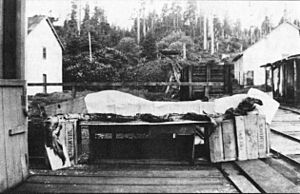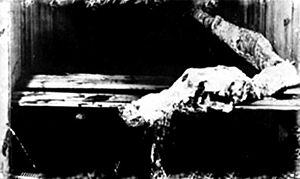Cadborosaurus facts for kids
Cadborosaurus, often called Caddy, is a mysterious sea creature from stories along the Pacific Coast of North America. Its name comes from Cadboro Bay in British Columbia. The word "saurus" means "lizard" or "reptile" in Greek. People have reported seeing Caddy for a long time, making it a famous part of local folklore.
Contents
What Does Cadborosaurus Look Like?
Witnesses describe Cadborosaurus willsi as a serpent-like creature. It often has vertical coils or humps behind its head. Its head is said to look like a horse. Caddy has a long neck and a pair of small front flippers that help it move up. It might also have back flippers or a large, fan-like tail for powerful swimming.
Scientists like Dr. Paul LeBlond from the University of British Columbia and Dr. Edward Blousfield have studied Caddy. They say many long animals have been suggested as Caddy, such as eels, whales, and sharks. However, they believe no known animal perfectly matches the descriptions from over 200 sightings. They note that Caddy is described as having flippers at both the front and back of its body.
Animals Sometimes Mistaken for Caddy
Many different animals have been confused with Cadborosaurus. Here are some of them:
Could Caddy Be a Sea Lion?
In 1943, two police officers, Inspector Robert Owens and Staff Sergeant Jack Russell, thought they saw a "huge sea serpent" in Georgia Strait. Later, they used binoculars. Sergeant Russell realized it was a large male sea lion leading a group of six other sea lions. As they swam, their movements made them look like one long body. To the unaided eye, it looked exactly like a sea monster.
Is Caddy a Giant Oarfish?
Some people think Caddy might be a king of herrings, also known as a giant oarfish (Regalecus glesne). These fish can grow very long, up to 17 meters (about 56 feet), and weigh up to 300 kilograms (about 660 pounds). H.J. Walker, a scientist, said these fish are "long and silvery." They "undulate like a serpent" when they swim, which could explain some Caddy sightings.
What About a Basking Shark?
The body of a basking shark that is breaking down often looks like Caddy. Even experts have been fooled by these decomposing sharks. A rotting basking shark can also look like a prehistoric plesiosaur.
Was It a Pipefish?
In 1968, a whaler named William Hagelund claimed to have caught a baby "Cadborosaurus." However, some researchers, including Michael Woodley, Darren Naish, and Cameron McCormick, believe this baby creature was actually a pipefish.
First Nations Stories of Caddy
Native peoples in Alaska have traditional images that look like Caddy. These images suggest that Caddy, or a similar creature, moves north to Vancouver when the waters get warmer. The Inuit people of Alaska even put pictures of this creature on their canoes to keep it away.
Different First Nations groups have their own names for the Cadborosaurus:
- The Manhousat people, who live on Sydney Inlet, call it hiyitl'iik.
- In Sechelt mythology, it is known as t'chain-ko.
- The Comox band on Vancouver Island call it numkse lee kwala.
Where Have People Seen Caddy?
Over the past 200 years, there have been more than 300 reported sightings of Cadborosaurus. These sightings have happened in many places. Some common locations include Deep Cove and Island View Beach in Saanich Inlet, both near Cadboro Bay in British Columbia. People have also reported seeing Caddy in San Francisco Bay, California.
The Kelly Nash Video
In 2009, a fisherman named Kelly Nash reportedly filmed several minutes of footage. He claimed it showed ten to fifteen creatures, including young ones, in Nushagak Bay. A very short part of this video was shown on the Discovery TV show Hilstranded in 2011. The Hilstrand brothers, known from Deadliest Catch, apparently saw Nash's video. They then tried to find one of the creatures but were not successful.
Bodies Thought to Be Caddy
Sometimes, strange animal remains are found and thought to be Cadborosaurus. However, most of these have later been identified as known animals.
- 1930: On November 10, a 24-foot-long skeleton with flippers was found in ice near Valdez. Parts of it were saved for study. This creature was later thought to be a whale.
- 1934: In November, badly decomposed remains about 30 feet long were found on Henry Island near Prince Rupert. Dr. Neal Carter examined them. The creature was identified as a basking shark.
- 1937: In October, a body believed to be Cadborosaurus was found inside a sperm whale in Naden Harbour and photographed. A piece of this body was sent to the BC Provincial Museum. The museum director, Francis Kermode, thought it was a fetal baleen whale.
- 1941: A body nicknamed "Sarah the sea hag" was found on Kitsilano Beach. Scientists W.A. Clemens and Ian McTaggart-Cowan identified it as a shark.
- 1947: In December, a 45-foot creature was found at Vernon Bay, Barkley Sound, Vancouver Island. It was identified as a shark.
- 1950: In Delake, Oregon, a creature with four tails and thick hair was found. It was identified as a whale shark.
- 1956: Near Dry Harbour south of Yakutat, Alaska, a 100-foot-long body with two-inch-long hair was found. Scientist Trevor Kincaid said its "description fits no known creature." However, W.A. Clemens later identified it as a Baird's beaked whale.
- 1962: In April, a 14-foot-long body with an elephant-like head was found near Ucluelet. Simon Peter dragged it ashore. It was later thought to be an elephant seal.
- 1963: In September, a body with a horse-like head was found near Oak Harbor, Whidbey Island. A. D. Welander of Fisheries believed it was a basking shark.
Claims of Live Capture
There have been a few claims of people catching a live Cadborosaurus, even if only for a short time.
- 1968: In August, W. Hagelund claimed to have caught a baby Caddy near De Courcy Island.
- 1991: In July, on Johns Island in the San Juan Islands, Phyllis Harsh claimed to have caught a small, 2-foot baby Caddy. She then returned it to the water.



